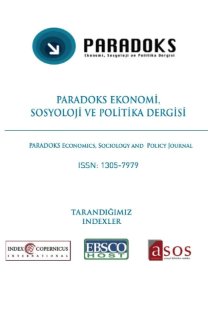DÖVİZ KURLARINDAKİ DEĞİŞKENLİK İLE DIŞ TİCARET ARASI İLİŞKİLER: TÜRKİYE ÜZERİNE TODA-YAMAMOTO NEDENSELLİK ANALİZLERİ (2003:M1 – 2017:M11)
Bu çalışmanın amacı, 2001 Krizinden sonra yönetimli dalgalı kur rejimine geçen Türkiye ekonomisinde döviz kuru değişkenliği ile ticaret arasındaki ilişkileri ampirik olarak test etmektir. Çalışmada döviz kurlarındaki değişkenliği veya dalgalanmayı ölçmeye yönelik olarak literatürde yoğun bir şekilde kullanılan ve hareketli ortalamalara dayanan yönteme yer verilmiştir. Bu yöntemle elde edilen değişken ile dış ticaret değişkenleri arasında nedensel ilişkiler, Toda-Yamamoto nedensellik analiziyle belirlenmiştir. Çalışmadan elde edilen ampirik bulgulara göre döviz kuru değişkenliği ile ithalat arasında iki yönlü nedensel ilişkiler söz konusu iken, ihracattan döviz kuru değişkenliğine doğru tek yönlü nedensellik yakalanmıştır. Ayrıca ihracat ve ithalatın alt kalemleri ile döviz kuru değişkenliği arasında farklılaşan sonuçlar söz konusudur. Döviz kuru değişkenliğinden tüketim malları ithalatı değişkenine doğru tek yönlü nedensellik bulunmuşken, diğer tüm ticaret değişkenlerinden döviz kuru değişkenliğine doğru tek yönlü nedensellik bulunmuştur. Dolayısıyla çalışmada elde edilen bu sonuçlar, döviz kuru değişkenliğinin Türkiye’nin dış ticaretini etkileyebildiğini ortaya koymaktadır. Bu kapsamda döviz kuru değişkenliğinin azaltılarak sabit veya istikrarlı kurların tesisi, Türkiye’nin dış ticaretine olumlu etkilere neden olabilecektir.
Anahtar Kelimeler:
Döviz Kuru Değişkenliği, Dış Ticaret
EXCHANGE RATE VOLATILITY AND FOREIGN TRADE: TODA-YAMAMOTO CAUSALITY ANALYSIS FOR TURKEY(2003:M1 – 2017:M11)
The purpose of this study is to test empirically relations between exchange rate volatility and trade in Turkey where the floating exchange rate regime implemented after the 2001 crisis. In the study, a method based on moving average, which is used extensively in the literature, is used to measure the variability or fluctuation in exchange rates. The causal relations between the variable that obtained by this method and foreign trade variables were determined by Toda-Yamamoto causality analysis. According to the empirical findings obtained from the study, two-way causality between exchange rate volatility and import are mentioned while there is a one-way causal relationship from export to exchange rate volatility. There are also different results between the sub-items of export and import and exchange rate volatility. While one-way causality was found from the exchange rate volatility to the import variable of the consumption goods, one-way causality from the other trade variables to the exchange rate volatility was found. Thus, these results obtained in the study, suggesting that the exchange rate volatility can affect Turkey's foreign trade. In this context, reducing the exchange rate volatility or the establishment a stable exchange rate, Turkey's foreign trade could result in a positive impact.
Keywords:
Exchange Rate Volatility, Foreign Trade,
___
- Aftab, M., Ahmad, R., Ismail, I. & Ahmed, M. (2016). “Does Exchange-Rate Uncertainty Matter in the Malaysia–EU Bilateral Trade? An Industry Level Investigation”, Empirica, 43(3), 461-485.
- Aliyu, S. U. R. (2010). “Exchange Rate Volatility and Export Trade in Nigeria: an Empirical Investigation”, Applied Financial Economics, 20(13), 1071-1084.
- Anderton, R. and Skudelny, F. (2001). “Exchange Rate Volatility and Euro Area Imports”, Working Paper No. 64, European Central Bank, Frankfurt.
- Arize, A. C., Osang, T. & Slottje, D. J. (2000). “Exchange-Rate Volatility and Foreign Trade: Evidence from Thirteen LDC's”, Journal of Business & Economic Statistics, 18(1), 10-17.
- Bahmani-Oskooee, M. & Gelan, A. (2018). “Exchange-Rate Volatility and International Trade Performance: Evidence from 12 African Countries”, Economic Analysis and Policy, 58(2), 14-21.
- Caporale, T. & Doroodian, K. (1994). “Exchange Rate Variability and the Flow of International Trade”, Economics Letters, 46(1), 49-54.
- Choudhry, T. (2008). “Exchange Rate Volatility and United Kingdom Trade: Evidence from Canada, Japan and New Zealand”, Empirical Economics, 35(3), 607-619.
- Chowdhury, A. R. (1993). “Does Exchange Rate Volatility Depress Trade Flows? Evidence from Error-Correction Models”, The Review of Economics and Statistics, 700-706.
- Çakmak, E., & Çınar, S. (2004). “Bankacılık Sektöründe Toplam Hizmet Kalitesinin Satınalma Gücü Paritesi ve Türkiye Üzerine Bir Uygulama: 1980-2002”, Gazi Üniversitesi İktisadi ve İdari Bilimler Fakültesi Dergisi, 6(1), 33-46.
- Denaux, Z. S., & Falks, R. (2013). “Exchange Rate Volatility and Trade Flows: the EU and Turkey”, Southwestern Economic Review, 40, 113-121.
- Hacker, R. S. & Hatemi‐J, A. (2004). “The Effect of Exchange Rate Changes on Trade Balances in the Short and Long Run”, Economics of Transition, 12(4), 777-799.
- Hayakawa, K. & Kimura, F. (2009). “The Effect of Exchange Rate Volatility on International Trade in East Asia”, Journal of the Japanese and International Economies, 23, 395-406.
- Kızıldere, C., Kabadayı, B., & Emsen, Ö. S. (2014). “Dış Ticaretin Döviz Kuru Değişimlerine Duyarlılığı: Türkiye Üzerine Bir İnceleme”, International Journal of Economic & Administrative Studies, 6(12), 39-54.
- Meniago, C. & Eita, J. H. (2017). “Does Exchange Rate Volatility Deter Trade in Sub-Saharan Africa?”, International Journal of Economics and Financial Issues, 7(4), 62-69.
- Shehu, A. A. & Youtang, Z. (2012). “Exchange Rate Volatility, Trade Flows and Economic Growth in a Small Open Economy”, International Review of Business Research Papers, 8(2), 118-131.
- Tatlıyer, M. & Yiğit, F. (2016). “Does Exchange Rate Volatility Really Influence Foreign Trade? Evidence from Turkey”, International Journal of Economics and Finance, 8(2), 33-38.
- Toda, H. Y. & Yamamoto, T. (1995). “Statistical Inference in Vector Autoregressions with Possibly Integrated Processes”, Journal of Econometrics, 66(1-2), 225-250.
- ISSN: 1305-7979
- Yayın Aralığı: Yılda 2 Sayı
- Başlangıç: 2005
- Yayıncı: Sema AY
Sayıdaki Diğer Makaleler
KALKINMA AJANSLARININ BÖLGE PLANLARINDA ENTEGRE KIRSAL KALKINMA YAKLAŞIMI
SLOW CITY HAREKETİNDEN SLOW FOOD HAREKETİNE DOĞRU GİDERKEN BELEDİYELERİN ROLÜ
Muharrem Akin DOĞANAY, Mürşit RECEPOĞLU, Mustafa Kemal DEĞER
YAŞANABİLİR KENTLER İNŞA ETME SÜRECİNDE KENTSEL DÖNÜŞÜM ÇALIŞMALARININ ANALİZİ: BURSA ÖRNEĞİ
KENTSEL DÖNÜŞÜM KONULU TEZ ÇALIŞMALARINDA (1999-2017) ÖNE ÇIKAN KONULAR, SORUNLAR VE ÖNERİLER
Pinar TUĞCU, Tülin VURAL ARSLAN
HİYERARŞİK KÜMELEME ANALİZİ İLE OECD ÜLKELERİNİN BİLGİ EKONOMİ İNDEKSLERİNE GÖRE SINIFLANDIRILMASI
İSTİHDAM POLİTİKALARININ OLUŞTURULMASINDA İŞKUR’UN ETKİNLİĞİ VE ÖZEL İSTİHDAM KURUMLARI
